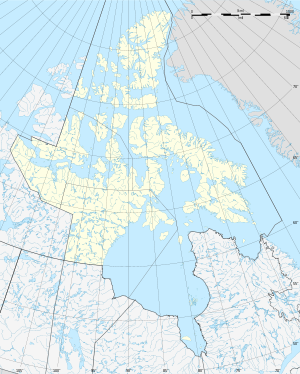Exmouth Island
| Exmouth Island
| ||
|---|---|---|
 | ||
| Gewässer | Belcher-Kanal | |
| Inselgruppe | Königin-Elisabeth-Inseln | |
| Geographische Lage | 77° 13′ 7″ N, 95° 52′ 42″ W | |
|
| ||
| Länge | 3,6 km | |
| Breite | 2,9 km | |
| Fläche | 6,9 km² | |
| Höchste Erhebung | Milne Peak 182 m | |
| Einwohner | unbewohnt | |
Exmouth Island ist eine unbewohnte Insel in der Qikiqtaaluk-Region des kanadischen Territoriums Nunavut.
Geographie
[Bearbeiten | Quelltext bearbeiten]Exmouth Island bildet mit Table Island und Ekins Island eine Inselgruppe, die im Belcher-Kanal zwischen der Devon Island im Süden und Cornwall Island im Norden liegt. Die Insel ist oval mit einer kleinen Halbinsel im Nordosten. Sie ist 3,6 km lang und bis zu 2,9 km breit. Vom zentralen Plateau, das im Milne Peak eine Höhe von 182 m erreicht, fällt das Gelände nach allen Seiten steil ab.
Die Insel besteht aus rotem Sandstein, nur die oberste ca. 35 m dicke Schicht besteht aus fossilienhaltigem Kalkstein aus der Mitteltrias.[1][2]
Geschichte
[Bearbeiten | Quelltext bearbeiten]Edward Belcher entdeckte die Insel am 27. August 1852 auf der Suche nach der verschollenen Franklin-Expedition. Er benannte sie in Gedenken an die Bombardierung Algiers im Jahr 1816 durch ein von Admiral Edward Pellew, 1. Viscount Exmouth, geführtes britisch-niederländisches Geschwader, die sich an diesem Tag jährte.[3] Belcher hatte an Bord der HMS Superb selbst an dieser Militäraktion teilgenommen.[4] Von Exmouth Island brachte er einige Fossilien, darunter die eines Ichthyosaurus, zurück nach England, die von John William Salter und Richard Owen wissenschaftlich beschrieben wurden.[5][1]
Einzelnachweise
[Bearbeiten | Quelltext bearbeiten]- ↑ a b R. Owen: Note on some Remains of an Ichthyosaurus Discovered by Captain Sir Edward Belcher, C.B., R.N., at Exmouth Island, in lat. 77° 16′ N., long. 96° W. In: Edward Belcher: The last of the Arctic voyages; being a narrative of the expedition in H.M.S. Assistance, under the command of Captain Sir Edward Belcher C.B., in search of Sir John Franklin, during the years 1852–53–54. Band 2, Lovell Reeve, London 1855, S. 389–391 (englisch).
- ↑ Dale A. Russell: Mesozoic Vertebrates of Arctic Canada. In: C. R. Harington (Hrsg.): Canada’s missing dimension. Science and history in the Canadian Arctic Islands. Band 1, Canadian Museum of Nature, Ottawa 1990, ISBN 0-660-13054-8. S. 81–90 (englisch).
- ↑ Edward Belcher: The last of the Arctic voyages; being a narrative of the expedition in H.M.S. Assistance, under the command of Captain Sir Edward Belcher C.B., in search of Sir John Franklin, during the years 1852–53–54. Band 1, Lovell Reeve, London 1855, S. 105 f. (englisch).
- ↑ William Richard O’Byrne: A Naval Biographical Dictionary. John Murray, London 1849, S. 68 (englisch).
- ↑ J. W. Salter: Account of the Arctic Carboniferous Fossils. In: Edward Belcher: The last of the Arctic voyages; being a narrative of the expedition in H.M.S. Assistance, under the command of Captain Sir Edward Belcher C.B., in search of Sir John Franklin, during the years 1852–53–54. Band 2, Lovell Reeve, London 1855, S. 377–389 (englisch).
Weblinks
[Bearbeiten | Quelltext bearbeiten]- Exmouth Island bei Natural Resources Canada
- Exmouth Island im Atlas of Canada

